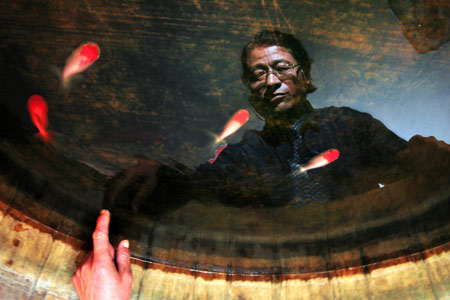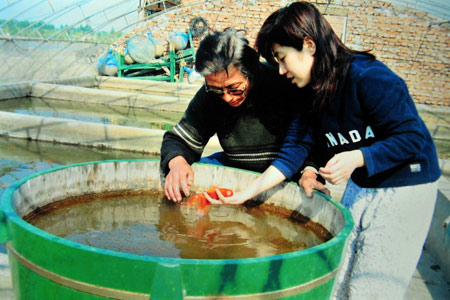Life
A sight for kings
By Xu Lin (China Daily)
Updated: 2010-12-28 08:04
 |
Large Medium Small |
|
 Xu Jianmin, the 10th generation descendant of "Goldfish Xu", raises royal goldfish, a skill handed down by his ancestors. Photos by Li Fei / For China Daily |
|
 Xu Jianmin and his daughter Xu Jia work in the fishery he opened in suburban Beijing. |
Raising the royal goldfish, the showpiece of ornamental ponds and water gardens in imperial China, is a dying tradition. Xu Lin reports
For Xu Jianmin, 54, raising goldfish is not just about the love of a species. It is more about restoring the quintessence of Chinese culture. "I feel responsible for carrying forward a unique skill handed down by my ancestors," Xu says.
Goldfish belong to the carp family and were first found in rivers and lakes. Its golden color is the result of a natural gene mutation. The species was domesticated more than a 1,000 years ago in China and then introduced to other countries.
Xu is the 10th generation descendant of the family, known as "Goldfish Xu", that raised goldfish in the Forbidden City for emperors of the Qing Dynasty (1644-1911) for more than 200 years.
"Compared with ordinary goldfish, the royal ones are bigger breeds with brighter colors and longer lives," he says.
It was in 1934 that the mysterious royal goldfish was first unveiled to the public at an exhibition in Zhongshan Park.
"Royal goldfish were not allowed outside the palace. Those found were killed," Xu says.
The secret to the beauty of the royal variety, Xu says, lies in four elements - purity of the breed, water, fish food and light. It is important to know when to change the water, how many times a day to feed the fish and how much light to allow the fish in different seasons, he explains.
"There are a thousand combinations of the four elements for different growth stages. Only an experienced breeder can master them," he says.
Like pandas, goldfish have played an essential role in China's diplomacy. Xu's father, Xu Jinsheng, flew to India in 1954, with 100 pairs of goldfish as a birthday present for India's first prime minister, JawaharlalNehru.
"There were more than 300 goldfish varieties in the heyday. By the time of my father's generation, only about 60 were left," he says.
During the "cultural revolution" (1966-1976), many royal goldfish were destroyed, including a plaque to "Goldfish Xu" written by Emperor Qianlong.
"The Chinese goldfish industry never recovered from that," Xu sighs.
Royal goldfish used to be raised in big cypress-wood basins and earthen pots, which were durable, breathed well and were able to withstand temperature changes.
"But making them was expensive, cumbersome and labor-intensive and wasn't handed down," he says.
Xu says such containers are crucial for royal goldfish, but he can only make imitations based on a vague childhood memory and sometimes has to use cement tanks instead.
In many Chinese fisheries, goldfish are raised in large pools for mass production, which results in poorer quality, in terms of shape, color and life expectancy.
"Goldfish with short life spans now dominate the market. That's why people feel domesticated goldfish die easily and are unwilling to raise them," he says.
Xu's supply is not adequate to meet the demand for high-quality goldfish, especially from Japan, South Korea, and Southeast Asian countries, as the goldfish is a symbol of wealth and good luck in their cultures too.
"Goldfish from Japan and Taiwan account for more than 80 percent of the international market. However, mainland goldfish are known for their lower price and quantity, thanks to an unregulated market," he says.
Xu learned how to raise goldfish as a child while working with his father, employed by Ditan Park as a breeder. But the park's new incentive structure in 1989, that linked payments to fish sales, did not suit the Xus and young Xu switched to driving taxis.
Known for his whistling skills, in 1997 he also started moonlighting around the country to make some extra money.
In 2002 his father died, making one last appeal to save the family business of goldfish rearing from disappearing.
Xu heard a radio report that a Japanese student, in the aftermath of the demolition of old houses, had cycled around Beijing to buy old door frames and hold an exhibition.
That served as a wake-up call for him to do something to preserve a generations-old cultural tradition.
Xu quit his job and opened his fishery in 2004, using his savings of 300,000 yuan ($45,000).
Of his more than 200,000 goldfish, less than 1,000 are top-level ones, whose prices are up to 10,000 yuan.
"Many buyers are wealthy, but I will not sell to those with no experience raising goldfish," he says.
He says he can barely make ends meet, as this is an industry for big investment and slow profit.
Another challenge has been to find a fixed place for the fishery - he has already moved three times in six years.
Xu currently has two apprentices besides his daughter, who wants to follow in her father's footsteps after graduation.